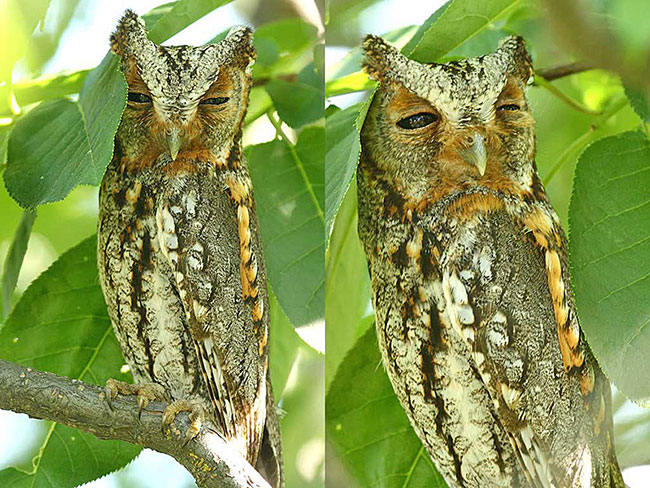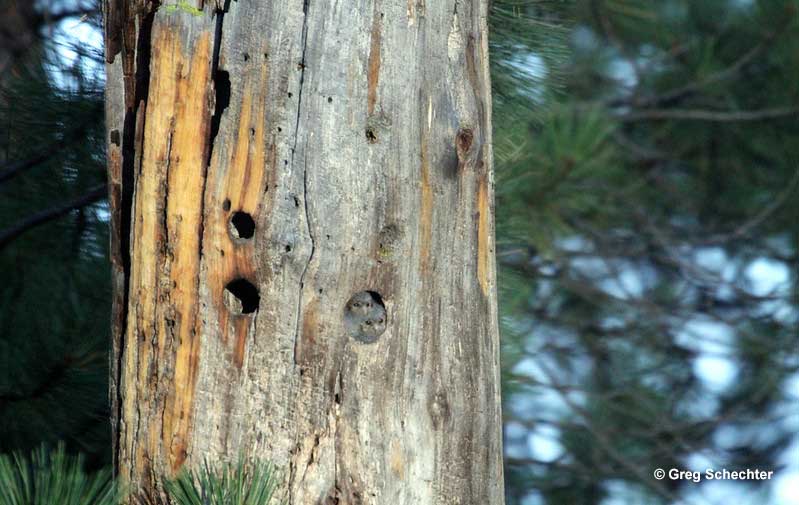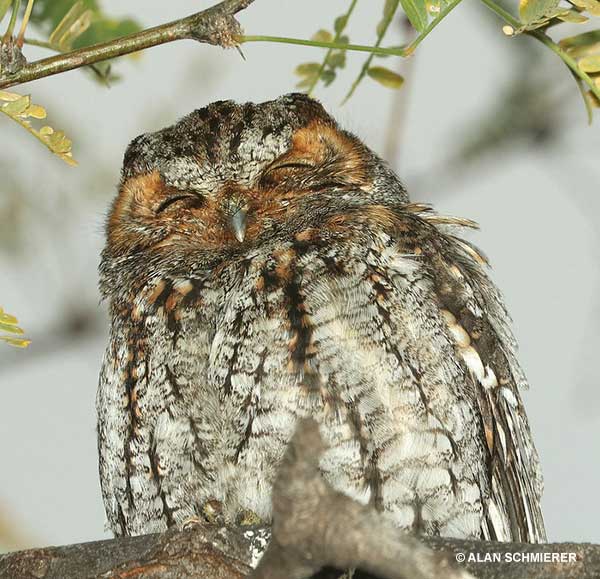The Flammulated Owl (Psiloscops flammeolus) is a small, gray and red-brown owl with dark eyes, and long wings.
Flammulated Owls can be locally common but hard to find. They are best detected by listening for their single hoot vocalization on early summer nights in mature western forests.
If you hear a single hoot note repeated on a regular basis in aspen groves and spots with big, old Ponderosa Pines, you may have found a Flammulated Owl!
On this page
Identification
Male
The male Flammulated Owl is a very small, nocturnal owl with short ear tufts. It has deep, dark brown eyes, and a gray and red-brown face.
Flammulated Owls are just 6.75 inches long, have a wingspan of 16 inches, and weigh 1.7 ounces. They are mottled ashy-gray above with red-brown markings and some pale spotting on their wings.
These small owls also have some pale markings above and between their eyes, and can show a narrow dark border on their face.
Male Flammulated Owls make a single hoot note repeated every two or three seconds. It sounds surprisingly low-pitched for the size of the bird!
Female
The female Flammulated Owl looks just like her male counterpart. She can be slightly bigger, but unlike most owl species, there is very little size difference between male and female Flammulated Owls.
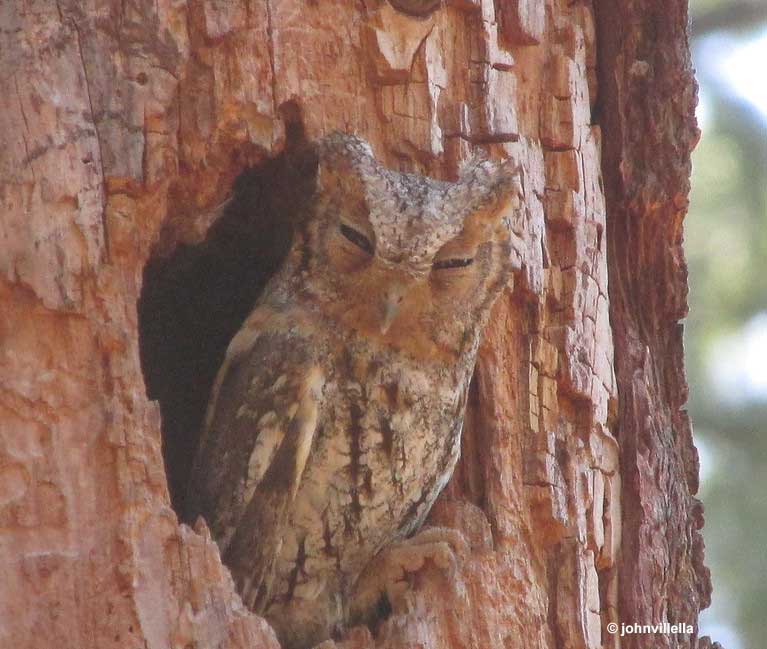
Male and female Flammulated Owls look identical, but females can be slightly bigger than males. © johnvillella
She is just as small (around the size of a grosbeak), has a similar weight, and also has similar, longish wings.
Like the males, female Flammulated Owls have gray and red-brown chests with some thick, black and red-brown streaks on their underparts. Their belly and undertail are white.
They also have buff barring on their wing feathers and a couple of buff bands on their short, broad tail.
Food
The Flammulated Owl feeds on insects. It eats moths of all sizes and also preys on crickets, grasshoppers, many beetles, and other nocturnal insects. In spring, this small owl may depend Geometrid and Owlet moths, the only insects active on cold nights in its montane habitat.
Read more: What do owls eat?
Flammulated Owls are only active at night and seem to prefer hunting in semi-open mature forests with brush and other healthy understory habitats. They catch their insect prey in a few different manners.
Like a flycatcher of the night, this owl can wait on a perch before flying into the air and using its talons to snatch a moth. It can also fly down to catch insects on the ground, and also takes them from foliage.
After catching an insect, this owl returns to a favorite perch and holds the bug down with its talons while tearing it apart with its beak.
Unlike many other nocturnal owls, Flammulated Owls are believed to catch more of their prey by watching for them. They certainly have good hearing but may rely more on eyesight than other owl species.
When few insects are available, on very rare occasions, Flammulated Owls have also been documented bringing dead mice and small birds to their nest.
Nesting and Eggs
In late April and May, male Flammulated Owls sing to attract and pair with the same female as the previous year, or find a new mate. When a female picks a male, he shows her several possible nest sites and she chooses one for the nest.
These birds nest in old woodpecker holes, especially ones made by Northern Flickers. Once in a while, they also use old cavities made by Pileated Woodpeckers and Acorn Woodpeckers.
Shortly after picking a hole for a nest, the female Flammulated Owl lays two to three, creamy-white eggs directly on the floor or bottom of the cavity. The eggs are 1.2 inches long, weigh .37 ounces, and are incubated by the mother owl for three weeks.
During that time, the male owl feeds her. After the eggs hatch, he keeps bringing her food as well as food for the baby owls for eight to twelve days. Nearly two weeks after hatching, the mother owl also starts bringing food for the nestlings.
The young owls leave their nest a bit more than three weeks after hatching and move to nearby areas over the following 30 days. In the meantime, the fledgling owls learn to catch food while still being occasionally fed by their parents.
Current Situation
Flammulated Owls breed in mature, open pine and aspen forests in parts of southern British Columbia, and at scattered sites in the Rocky Mountains and the western USA. These small owls also breed in similar montane forests in Mexico.
Little is known about their wintering habitat, but they are thought to migrate to highland forests in Mexico and northern Central America.
The Flammulated Owl is an uncommon and local species listed as Least Concern on the IUCN Red List.
These small owls are believed to have a large and stable population, but their true status can be evasive.
They are very difficult to study, tend to disappear from areas that have been logged, and may be sensitive to pesticides. Furthermore, very little is known about their ecology on their wintering grounds, and the threats they may face there.
Since Flammulated Owls are sensitive to habitat alteration, and raise few young, they are considered a Bird of Conservation Concern by U.S. Fish and Wildlife Service, and a species of Special Concern in Canada.
Facts
- When calling, Flammulated Owls appear to frequently throw their voice to hide their exact location, and make surprisingly deep, hooting calls for their size. These are probably adaptations to avoid larger owls that prey on them.
- Unlike many other small owls, this species does not usually feed on rodents. Insects make up the largest part of its diet and is why this bird migrates south for the winter.
- Flammulated Owls lack the special feather adaptations for quiet flight that other owls have. Since they catch insects, they don’t need to fly as quietly as other owl species.
- This is one of the only owls that nests in colonies. While other owl species occur as pairs scattered across a landscape, Flammulated Owls occur as clusters of birds that breed in the same area.
- The name of this owl, “flammulated” means “flame-colored” and refers to the red-brown highlights in its plumage.
Similar Species
The Flammulated Owl looks a lot like a few other small owl species. Fortunately, with a good look, this small owl can be easily identified.
Western Screech-Owl
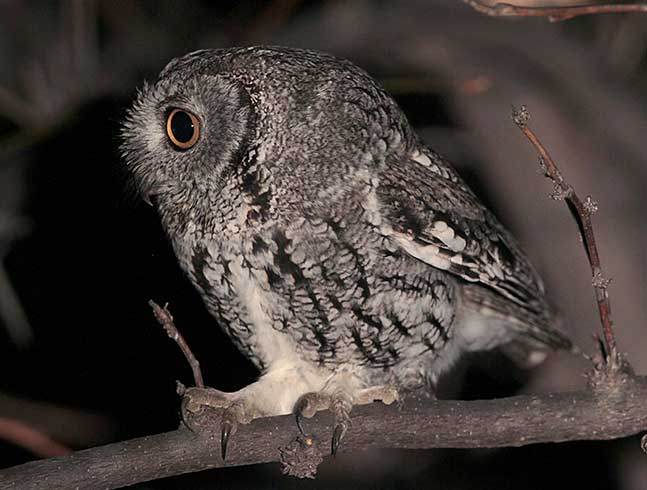
These small owls also have ear tufts, but are slightly bigger than the Flammulated Owl. One of the easiest ways to tell them apart is by looking at their eyes.
Western Screech-Owls have yellow eyes, while the Flammulated Owls have dark eyes. The Western Screech-Owl is also a colder gray or brown bird that lacks red-brown in its plumage.
Whiskered Screech-Owl
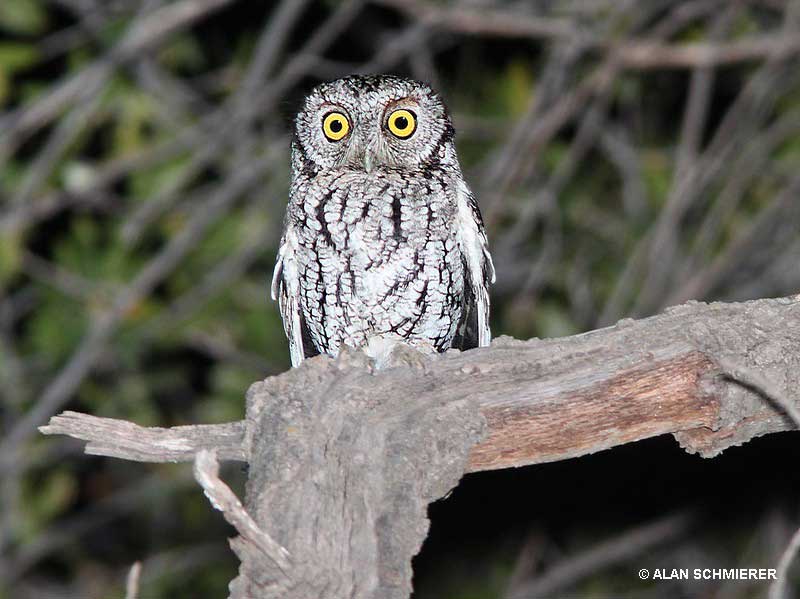
Whiskered Screech-Owl is another small owl with ear tufts and can live in some of the same places as the Flammulated Owl. However, it has orange-yellow eyes and does not have any red-brown colors in its plumage.
Elf Owl
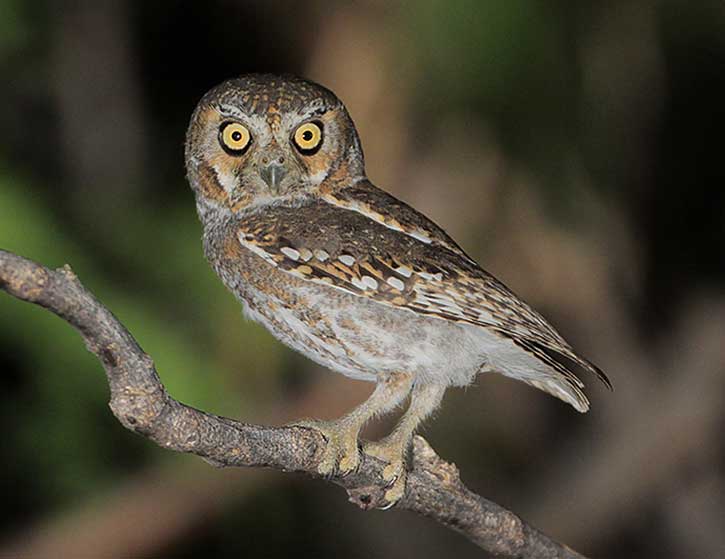
The Elf Owl is a tiny owl, colored a lot like a Flammulated Owl. However, it is even smaller, around the size of a sparrow! It also lacks ear tufts and has pale eyes.
The Flammulated Owl always shows dark eyes.
Frequently Asked Questions
What is the Flammulated Owl called?
The Flammulated Owl is also called, “Flammulated Screech-Owl”, “Flammulated Scops Owl”, and “Flammie”.
How rare are Flammulated Owls?
Flammulated Owls are not rare. However, since they are nocturnal and secretive, they can be hard to find.
How big are Flammulated Owls?
Flammulated Owls are pretty small birds. They are around the same size as a grosbeak!
How long does a Flammulated Owl live?
A Flammulated Owl lives for ten years or more.
What is the difference between a screech owl and a Flammulated Owl?
The difference between a screech owl and a Flammulated Owl is that Flammulated Owls are smaller, have dark eyes, and much smaller ear tufts.
What is the difference between a Flammulated Owl and a Western screech owl?
The difference between a Flammulated Owl and a Western Screech-Owl is that the Flammulated Owl is smaller, has dark eyes, and red-brown highlights in its plumage.

